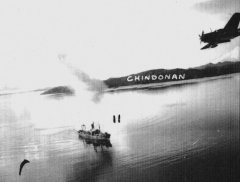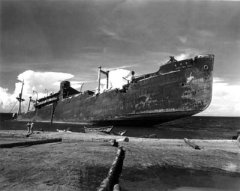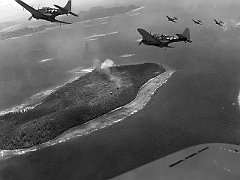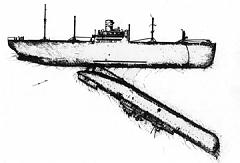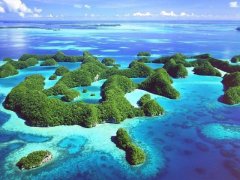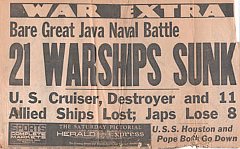|
|
57 Images This Arctic Circle location was the scene of intense fighting during April and May 1940. Allied forces, headed by Great Britain, and Axis forces, headed by Germany, clashed fiercely to secure Narvik, which was a main shipping port for high-grade Swedish iron ore. The ore was a key element for the production of high-quality steel, and therefore critical to the armaments industries of both Great Britain and Germany. The fight for Narvik resulted in more than 55 surface ships, submarines, U-boats and airplanes being sunk in the clear water in and around the port city. Diving here is cold but extremely interesting with wrecks varying from merchant to navy shipping. In June 2003 a team of us dived the wrecks around Narvik from the Liveaboard Loyal Watcher run by Deep Blue Diving, which steamed over from their base in Plymouth. Divers used a mixture of open circuit and the KISS closed circuit Rebreather. |
|
||
|
189 Images In 1946 Bikini Atoll was the location selected for "Operation Crossroads", a sequence of tests designed to investigate the effect of atomic bombs on warships. A fleet of war surplus American and captured Japanese and German ships were moored in circles about ground zero - the point of detonation. All were fuelled and armed to represent the actual state of the ships during time of war. There were two blasts Able and Baker, which resulted in a total of 9 main diveable shipwrecks, from the immense aircraft carrier Saratoga, to the formidable Japanese battleship Nagato. Our team planned this amazing expedition for nearly two years. Due to the predominant use of the KISS closed circuit Rebreather the expedition had to overcome many logistical problems. These ranged from shipping out copious amounts of sofnalime and Helium required for the rebreathers months in advance of our arrival, to actually carrying all the KISS rebreathers from the UK to Bikini as baggage! Hard work but with such fantastic diving completely worth all the detailed planning. |
|
||
|
Philippines - Coron Bay (May 2004) 380 Images Between The Battle of the Philippine Sea on 19 and 20 June 1944 and The Battle of Leyte Gulf from 23 to 26 October 1944 the Japanese attempted to reinforce their forces which were occupying the Philippines. For divers, Coron's history started on 24 September 1944 when a US Navy strike force of fighters and dive bombers attacked a Japanese supply fleet of up to 24 ships at anchor in Coron Bay and around Busuanga Island. Today some 11 mainly intact shipwrecks are easily accessible to divers in depths down to 45m. We first read about this dive location in Diver and the lure of so many diveable ship wrecks in relatively shallow water was a major attraction for our team of UK wreck divers. Although far from the UK, Coron is a great place to dive and the team had a fantastic two weeks exploring the many wrecks. The team used a mixture of open circuit and the KISS closed circuit Rebreather. We booked up our diving and stay on Coron with Discovery Divers who were a great outfit and could provide Nitrox as well as Oxygen for the rebreathers and were very helpful in arranging the delivery of sufficient sofnalime from Manila. I would thoroughly recommend them to anyone planning a trip to Coron. |
|
||
|
Solomon Islands - Guadalcanal (August 2007) 277 Images The Guadalcanal campaign, also known as the Battle of Guadalcanal, was fought between August 7, 1942, and February 7, 1943, in the Pacific theatre of World War II. This campaign, fought on the ground, at sea, and in the air, pitted Allied forces against Imperial Japanese forces, and was a decisive, strategically significant campaign of World War II. The fighting took place on and around the island of Guadalcanal in the southern Solomon Islands and was the first major offensive launched by Allied forces against the Empire of Japan. We booked up our diving and stay in the Solomons with Tulagi Dive who were a great outfit and could provide the Oxygen and sofnalime for the rebreathers. Although the accomodation was basic I would recommend them to anyone planning a trip to the Solomons to dive the USS Aaron Ward. |
|
||
|
402 Images During World War II, Truk Lagoon was the Empire of Japan's main base in the South Pacific theatre. A significant portion of the Japanese fleet was based there, with its administrative center on Tonoas (south of Weno). Truk was used as the base for Japanese operations against Allied forces in New Guinea and the Solomon Islands. Due to heavy fortifications, both natural and manmade it was known to Allied forces as "the Gibraltar of the Pacific". Operation Hailstone, executed by the United States in 1944, culminated in one of the most important naval battles of the war at Truk. Twelve Japanese warships, thirty-two merchant ships and 249 aircraft were destroyed, although the larger warships had received advance warning and were already at sea. We booked up our diving and stay in the Chuuk with Blue Lagoon who were a great outfit and could provide the Oxygen for the rebreathers, although I had to arrange shipping of my own sofnalime. I would thoroughly recommend them to anyone planning a trip to Chuuk for a relaxing stay and well organised diving. |
|
||
|
36 Images As the largest island in Micronesia and the only American-held island in the region before World War II, Guam was captured by the Japanese on December 8, 1941, hours after the bombing of Pearl Harbor and was subsequently occupied for two and a half years. Guam is a popular stopping over point for divers visiting the region and for a wreck diver the opportunity to dive two wrecks which almost touch one another, each from a different world war, is a temptation worth exploring. Although trips are regularly scheduled to the two wrecks with MDA, the trips didn’t coincide with our stop over. Fortunately I knew Jim Pinson of GMI Wholesale who is a wealth of knowledge on Guam and he managed to make the arrangements for us to splash in on the SMS Cormoran and Tokai Maru. |
|
||
|
311 Images During WWII, Palau was a major Japanese military base. On March 30 and 31, 1944, the U.S. Navy lunched a two-day air-strike, designated as 'Desecrate One'. Bombers and fighter planes raided the Japanese fleet and sunk more than 60 ships and seaplanes in and around the lagoon. Although Truk Lagoon is regarded as Micronesia's wreck diving "Mecca", there were actually more ships sunk in and around Palau. Most went down close to Koror and among the more secluded Rock Islands. Generally, the ships lie in shallow water - between 15-30m - and are fairly accessable. Some of them have been heavily salvaged and are of no great diving interest now, but there are still some real gems that have remained remarkably intact and provide interesting and challenging dives. We booked up our diving in Palau with Fish n Fins. Although they were able to provide the Oxygen and sofnalime for the rebreathers, they rarely dive the wrecks and organising a trip focused on wreck diving with the freedom of utilising nitrox to extend times, took significant organisation and negotiations. With most people visiting Palau for the reefs they don’t have the demand for diving the wrecks and hence don’t focus on this aspect which I feel is a shame. |
|
||
|
Indonesia - Java Sea (October 2009) 141 Images The Battle of the Java Sea was a major naval battle of the Pacific campaign of World War II. The American-British-Dutch-Australian Command (ABDA) naval force suffered a disastrous defeat at the hand of the Imperial Japanese Navy, on February 27, 1942, and in secondary actions over successive days. The Japanese amphibious forces gathered to strike at Java, the main ABDA naval force, sailed northeast from Surabaya to intercept a convoy of the Eastern Invasion Force approaching from the Makassar Strait. The ABDA force consisted of two heavy cruisers (HMS Exeter, USS Houston) and three light cruisers (HNLMS De Ruyter (Doorman's flagship), HNLMS Java, HMAS Perth), and nine destroyers (HMS Electra, HMS Encounter, HMS Jupiter, HNLMS Kortenaer, HNLMS Witte de With, USS Alden, USS John D. Edwards, USS John D. Ford, and USS Paul Jones) The aftermath of the battle included several smaller actions around Java, including the smaller but also significant Battle of Sunda Strait. Overall it was the largest surface engagement since the Battle of Jutland in World War I. To dive these wrecks there is only one possibility by joining the liveaboard MV Empress skippered by Vidar, who has an amazing amount of knowledge on the wrecks of this entire region. |
|
||
|
261 Images Pretty Little Fish (PLF) diving from around the world.. actually most of these are on the bigger side & many have teeth at the business end! |
|
||
| Made with JAlbum & Chameleon | Help |


_Rudder3.jpg)
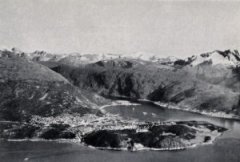
_USS Saratoga_Saratoga Bow Anchor Hawser.jpg)

_Akitsushima_Generator Room.jpg)
